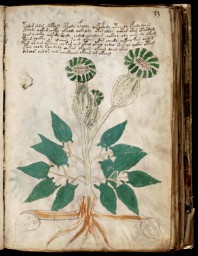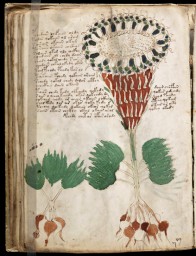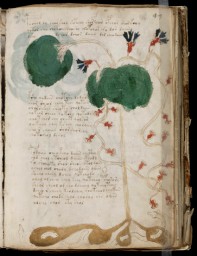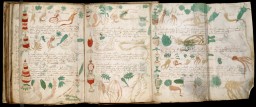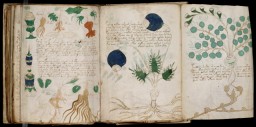The Voynich Botanical Garden | ヴォイニッチ植物園
The most of plants shown in the Voynich manuscript are suspected their actuality. A number of occult lovers have trasted it must be the botanical report from spitit world or unknown planet. However the purpose of discription might be unrialistic here from the start. It might be an excellent fake which was planned by John Dee and Edward Kelly to get on the gravy from Holly Roman Emperor Rudolph II who was very famous as the maniac of alchemy and "wunderkammer". Or it might be a manuscript of lovely fantasy that was written by unkown fanatic mistics.
That may or may not be true any more, despite the purpose of creation, I'm very impressed by the image of plants which were depicted here, for its free-spirited vitality and the tremendous unreality. Of course, there is nothing to be surprised very much in imagination of this author, as we know there had been many people who could see such a true nature of growning plants and put it in figures since the ancient time. We will look and find such a genious even in the common decor pattern.
However the authour of the Voynich manuscript accomplished a remarkable feat to make an extraordinal garden on the special place, pages of a book, and to keep the exuberance of strange plants forever, by use of expository text which was written in uundeciphered language. Those antic drawings in the king of rear books who never want to be read and understood seems to burst into laughing at the realism of surface.
ヴォイニッチ手稿の植物達はその実在が怪しまれるものが殆どである。霊界あるいは異星の植物学であると信じたいオカルト愛好者は多いことだろうが、もしかしたら最初から写実を目的としていないのかもしれない。ジョン・ディーとエドワード・ケリーが、錬金術や「驚異の部屋」作りに熱中する神聖ローマ皇帝ルドルフ二世をいっぱい担いでしこたま儲けようと企んだ、いかさまの逸品かもしれないし、知られざる狂気の神秘主義者がしたためた、愛すべき妄想かもしれない。
もはや真偽のほどは分らないが、創作の意図が何であれ、ここに描かれた植物の奔放な生命力、途方も無い在り得なさは一体何なのだろう。しかしながら、作者の想像力は驚かれるべきものではないだろう。成長する植物の本性を看破して、形象の中に封じることに秀でた人々は太古より数多く存在した。彼らの叡智の痕跡は、ありふれた装飾パターンの中にも、見出すことができるのだから。
しかしながら、ヴォイニッチ手稿の作者は、未だ解読されない言語で綴られた解説文らしきテキストと共に、書物のページという特別な空間の中で、比類の無い庭園を作り上げ、怪奇な植物達の繁茂を永遠に留め置く偉業をやってのけた。そのふざけたようなデッサンは、表層のリアリズムを爆発的に笑うかのようである。
ヴォイニッチ・マニュスクリプト
VOYNICH MANUSCRIPT
イェール大学ベイニッケ稀覯本図書館のサイトで、転載した画像を含む全頁を閲覧可能
http://beinecke.library.yale.edu/digitallibrary/voynich.html
"Written in Central Europe at the end of the 15th or during the 16th century, the origin, language, and date of the Voynich Manuscript—named after the Polish-American antiquarian bookseller, Wilfrid M. Voynich, who acquired it in 1912—are still being debated as vigorously as its puzzling drawings and undeciphered text. Described as a magical or scientific text, nearly every page contains botanical, figurative, and scientific drawings of a provincial but lively character, drawn in ink with vibrant washes in various shades of green, brown, yellow, blue, and red.
Based on the subject matter of the drawings, the contents of the manuscript falls into six sections: 1) botanicals containing drawings of 113 unidentified plant species; 2) astronomical and astrological drawings including astral charts with radiating circles, suns and moons, Zodiac symbols such as fish (Pisces), a bull (Taurus), and an archer (Sagittarius), nude females emerging from pipes or chimneys, and courtly figures; 3) a biological section containing a myriad of drawings of miniature female nudes, most with swelled abdomens, immersed or wading in fluids and oddly interacting with interconnecting tubes and capsules; 4) an elaborate array of nine cosmological medallions, many drawn across several folded folios and depicting possible geographical forms; 5) pharmaceutical drawings of over 100 different species of medicinal herbs and roots portrayed with jars or vessels in red, blue, or green, and 6) continuous pages of text, possibly recipes, with star-like flowers marking each entry in the margins."
「ヴォイニッチ手稿は、15世紀末もしくは16世紀の間に中欧で書かれたと思しいが、出自、言語、出版年については、その不可思議なドローイング、未だ解読されていないテキストと共に、未だ活発に議論されているところである。ヴォイニッチ手稿という名は、1912年にこのマニュスクリプトを手に入れたポーランド系アメリカ人古書籍商のウィルフリッド・M・ヴォイニッチの名に拠っている。魔術的かつ科学的なテキストが書かれ、ほとんどすべてのページにわたって、垢抜けないが愛すべき風情の、植物学的、具象的、科学的なドローイングがあり、緑、茶、黄、青、赤といった様々な色彩による鮮やかな彩色を添えて、インクで描かれている。
ドローイングの主題に基づいて、写本の内容は6つのセクションに分類される。
1)特定できない113種のドローイングを含む植物画
2)放射状の円陣に、太陽、月、さらに魚(双魚宮)、牡牛(金牛宮)、射手(人馬宮)といった黄道十二宮のシンボルを伴うアストラルチャートを含んだ天文的、占星術的なドローイング。パイプや煙突から現れる裸の女性たちと宮廷風の人物たち。
3)多くのドローイングを含む生物学的なセクション。小さな裸の女性たちはその殆どが膨らんだ腹部を持ち、液体の中に浸され、またその中を歩き、互に連結したチューブやカプセルを通じて奇妙に干渉し合っている。
4)9つの宇宙論的なメダリヨンの配列が入念に描かれている。多くがいくつかに折り畳まれたフォリオにまたがって描かれ、地理学的とも取れる形象が表されている。
5)異なる100種以上の薬草や根が、広口瓶や容器と共に赤、青、緑で描かれた、薬学的なドローイング
6)そして、おそらく調合レシピと思われるテキストのページが続く。星状の花が余白に描かれ、各見出しを示している。」
